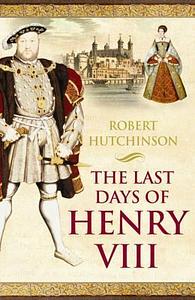Take a photo of a barcode or cover
This is a very well written and engrossing book about Henry VIII and his decline. It's strange though, while Hutchison keeps telling and to a degree showing the reader the trynnay and cruelty of Henry VIII, he also seems to be very much a fan. It is almost as if he is seperating Herny VIII from his actions.
The attempt to get rid of Katherine Parr by the conseratives at court is an example of this, where it Hutchsinon argues that Henry VIII seemed to set up a test of his queen, or perhaps to teach her a lesson. At some point, Hutchison implies that it was to teach his minsters a lesson as well. He could have gone into slightly more depth here.
Speaking of Katherine Parr, Hutchinson seems to be an admirer of her as well. In many ways, this excellent, short book, helps the reader prepare for the mercurical changes that occur under Edward and Mary, before the calm of Elizabeth.
In particular, Hutchison examines the question of the will as well as the cause of death of Great Harry. He doesn't seem to take a stand, which is understandable, and really does examine the various arguements, even in some cases dismissing some.
An engaging book.
The attempt to get rid of Katherine Parr by the conseratives at court is an example of this, where it Hutchsinon argues that Henry VIII seemed to set up a test of his queen, or perhaps to teach her a lesson. At some point, Hutchison implies that it was to teach his minsters a lesson as well. He could have gone into slightly more depth here.
Speaking of Katherine Parr, Hutchinson seems to be an admirer of her as well. In many ways, this excellent, short book, helps the reader prepare for the mercurical changes that occur under Edward and Mary, before the calm of Elizabeth.
In particular, Hutchison examines the question of the will as well as the cause of death of Great Harry. He doesn't seem to take a stand, which is understandable, and really does examine the various arguements, even in some cases dismissing some.
An engaging book.
challenging
informative
slow-paced
King Henry VIII, who ruled as a tyrant for almost 40 years, is dying. He caused mayhem and mischief by marrying six wives, killing two of them, with the dissolution of the monasteries, the creation of the Church of England, and his international policies. In short, it was a hot mess towards the end of his reign. So how did the last few months of King Henry VIII play out and how was he honored by those closest to the throne? Robert Hutchinson takes an in-depth look into this tumultuous period in history in his book, “The Last Days of Henry VIII: Conspiracies, Treason, and Heresy at the Court of the Dying Tyrant.”
I found this particular book in a used bookstore one day and decided to try it. I have heard of Robert Hutchinson, but I have never read any of his books.
Hutchinson begins with the day that King Henry VIII breathed his last breath on January 28, 1547. He is no longer the glamorous Renaissance prince, but rather he is a hugely obese man with festering wounds on his legs. The years have taken their toll on the king, but no one feels sympathy for the man. He has made so many around him live in abject terror for decades. Now, it is time for a fresh start with the reign of King Edward VI, his beloved son.
We then jump back in time so that Hutchinson can show his readers exactly why King Henry VIII was feared towards the end of his life. He starts with the last three marriages of Henry VIII, Anne of Cleves, Catherine Howard, and Katherine Parr. The way that Hutchinson characterized Anne of Cleves and Catherine Howard in this book irked me quite a bit, even though I know this book is older and there is new research about both queens that contradicts Hutchinson’s perspective.
Multiple marriages were not the only concern during the last years of Henry VIII’s life as he had to deal with heretics, international politics, and how the country should be run after his death. What I found truly fascinating about this book is the sources that Hutchinson used to tell the tale of the last years of Henry VIII’s life. They show how chaotically terrifying Henry’s court was towards the end. Hutchinson shows how the ambitious men around Edward VI tried to take control, but failed miserably as Edward VI, Mary I, and Elizabeth I ruled with just as much vigor as their powerful father. Finally, we see what happened to Henry VIII’s earthly remains and why his marvelous tomb vanished, leaving a simple marker to indicate where he and his beloved Jane Seymour were buried.
Hutchinson does his due diligence to show how maniacal Henry VIII was, especially towards the end of his life. He does not mince words in his opinions about Henry and his court, which I may not agree with completely, but he makes strong arguments for his opinions. Overall, a very well-written and informative book. If you want a book that explores the final years of the infamous king, I would suggest you check out, “The Last Days of Henry VIII: Conspiracies, Treason, and Heresy at the Court of the Dying Tyrant” by Robert Hutchinson.
I found this particular book in a used bookstore one day and decided to try it. I have heard of Robert Hutchinson, but I have never read any of his books.
Hutchinson begins with the day that King Henry VIII breathed his last breath on January 28, 1547. He is no longer the glamorous Renaissance prince, but rather he is a hugely obese man with festering wounds on his legs. The years have taken their toll on the king, but no one feels sympathy for the man. He has made so many around him live in abject terror for decades. Now, it is time for a fresh start with the reign of King Edward VI, his beloved son.
We then jump back in time so that Hutchinson can show his readers exactly why King Henry VIII was feared towards the end of his life. He starts with the last three marriages of Henry VIII, Anne of Cleves, Catherine Howard, and Katherine Parr. The way that Hutchinson characterized Anne of Cleves and Catherine Howard in this book irked me quite a bit, even though I know this book is older and there is new research about both queens that contradicts Hutchinson’s perspective.
Multiple marriages were not the only concern during the last years of Henry VIII’s life as he had to deal with heretics, international politics, and how the country should be run after his death. What I found truly fascinating about this book is the sources that Hutchinson used to tell the tale of the last years of Henry VIII’s life. They show how chaotically terrifying Henry’s court was towards the end. Hutchinson shows how the ambitious men around Edward VI tried to take control, but failed miserably as Edward VI, Mary I, and Elizabeth I ruled with just as much vigor as their powerful father. Finally, we see what happened to Henry VIII’s earthly remains and why his marvelous tomb vanished, leaving a simple marker to indicate where he and his beloved Jane Seymour were buried.
Hutchinson does his due diligence to show how maniacal Henry VIII was, especially towards the end of his life. He does not mince words in his opinions about Henry and his court, which I may not agree with completely, but he makes strong arguments for his opinions. Overall, a very well-written and informative book. If you want a book that explores the final years of the infamous king, I would suggest you check out, “The Last Days of Henry VIII: Conspiracies, Treason, and Heresy at the Court of the Dying Tyrant” by Robert Hutchinson.
What a great subject—-it’s just too bad the author chose to insert his prejudice and bias, on how Edward VI’s being raised by women contributed to his priggishness, and repeatedly in the first two chapters, his opinion of how silly or ugly some of the subjects of the book were.
It really took me out of what could have been a very interesting book.
It really took me out of what could have been a very interesting book.



